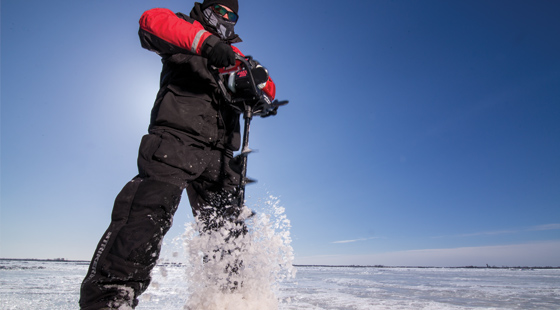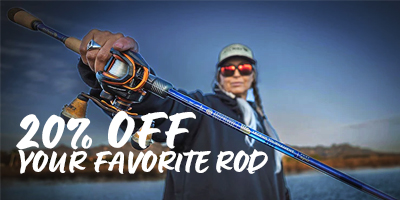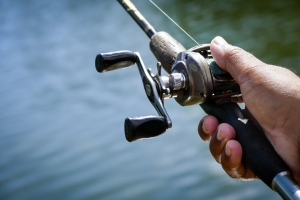Ice Augers – Choosing the best tool for the job.

There have never been so many options to simply put a hole in the ice. Gas augers, electric augers, propane augers, hand augers, even augers that attach to your cordless drill. Every style, type, and brand of auger has its Pros and Cons. Depending on your ice auger to do the job you need when you need it is critical for your hardwater success. We'll try and help narrow down your choice with our experiences with each auger class and model.
Let’s get this first thing out of the way.
Hand Augers
Your first decision is a budget decision. Hand augers are the most economical, and up to a few years ago, the only light weight option available. Hand augers typically don’t cost more than $100 and can be as cheap as $30. There are multiple blade options such as the Eskimo Silvertip Curved Blade and the Strikemaster Lazer both offering shaver blades that allow for smooth turns and “dig” into the ice to reduce the amount of effort needed to cut through the ice.
HAND AUGER PROS
Light Weight & Portable | Weight matters on early and late ice when you’re normally on foot and the amount of gear you carry can make a difference in how portable you are. The heaviest hand auger weighs in under 8 pounds.
Cost | Hand augers are the least expensive option in augers. The top of the line unit runs under $100.
HAND AUGER CONS
Effort, effort, and more effort | While portable in weight, hand augers are the least convenient for drilling multiple holes. A motivated fisherman can drill just as many holes with a hand auger as any power auger. Some would say more since they don’t need any energy the fisherman can’t provide. That said, the typical person will drill their 2-3 holes they plan on using that day and call it quits. Plus, once the ice is over 12” those 2-3 holes seem like 4-6 and gets worse with each hole.
Hand augers have their place. It’s just not on the ice with me. If you’re early/late icing it then look at the K-Drill or Pistol Bit further down.
The more power, more portability, less mess auger story.
Fuel Tech – The gas auger apocalypse or the right tools for the right job.
Less than 10 years ago 2-stroke gas augers dominated the market. Your choices basically come down to who made the best blades and the best engine and how big(heavy) did you want your auger to be. Strikemaster, Jiffy, and Eskimo all had choices to fit the bill and all worked as intended. Now things are changing faster than ever.
Gas Augers
3 mainstays in the industry, Strikemaster, Jiffy, and Eskimo, have run, more or less, the same gas augers for nearly 40 years with very little change. From 2hp – 71cc gas augers are the Tim Taylor choice in ice eaters. While weight of each varies by make and model. The power to weight ration is the best of all augers.
Choices in blade types vary between two styles, chipper or shaver. Chipper blades will re-open old holes, eat through any kind of ice, and are less prone to dulling; but they are a little more effort to cut with and typically need more HP to turn. Shaver blades like the Strikemaster Lazer cut like a knife and shave the ice a layer at a time. These blades are much easier to cut with but are much more prone to dulling and going “out of tune” which means the cutting angle is off making the blades nearly useless.
GAS AUGER PROS
Power to Weight | While not the lightest augers, they are the most powerful. If you’re looking a drilling thick, dense ice this is your baby.
Bullet Proof | Nearly 50 years of time-tested reliability.
Remote Use | Gas augers are still the best option for fishing remote lakes because they will start in almost all conditions, have the power needed for all conditions, and have a fuel that is transportable.
Budget Friendly | You can still get a good gas auger for under $300. Typically, they’ll have plenty of power for anything you need to do.
GAS AUGER CONS
Gas Oil Mix | While has augers have the power, that power comes at a cost. Get ready to haul around a separate mixed gas can. Don’t it on your gloves…. Eh, we all know why gas stinks. Also, the exhaust.
Yep, for us, that’s the only issue with gas augers. Some would say maintenance, but all augers have some sort of maintenance to keep them in top shape. We can fix the mixing with the next series of augers.
Propane Augers
In 2011 Jiffy introduced the game-changing 4-stroke Pro-4 propane auger. The propane augers have no oil to mix, less exhaust, and generally start in two pulls. They don’t have as much low-end power as gas augers and because they’re 4-stroke they’re a bit heavier. The Pro-4 was the first auger to change the thought that all augers need to be gas and few years later Eskimo came out with the HC40 high compression propane 4-stroke auger. It was built similarly to the Pro-4 but upped the compression-ratio to solve the low-end power issues the Pro-4 had. The new HC40’s work better in honey-combed or slushy ice conditions and the higher compression also allowed Eskimo to scale back the engine size and weight making it slightly more portable than the Jiffy.
PROPANE AUGER PROS
No Gas/Oil Mix | Because propane augers are 4-stroke there is no need to mix the oil and gas to the right ration.
No Gas Smell | Leave the gas cans at home! Just bring a few 1lb propane tanks and you have fuel for 100’s of holes.
Less Exhaust | Whether you’re drilling in your permanent shack or your set-up portable you’ll get less haze, smell, and fumes from the propane augers.
PROPANE AUGER CONS
Weight | Because the augers are 4-stroke they typically weigh more than your comparable HP gas augers.
Leaky Oil | While not mixing oil is a pro, the con is these are not sealed systems. The oil can(will) leak if they are set down improperly and before you know it the ice, your fish house, or your garage floor (from experience) will end up with 90% of your auger oil covering it. While for most this isn’t a deal breaker, it is inconvenient when all you want to do is drill a hole to fish.
Frequent oil changes | Propane fuel is cleaner and easier than gas, but it’s also hard on your oil and seals. Because of the acidity in propane you need to change your oil once or twice a season no matter how much you use the auger.
Overall propane augers are a step in the right direction but leave a lot to be desired. They work well for people with fish houses a ways-away from power and want to drill or re-drill holes without having to air out exhaust. However, the next category can do that and more with a little planning and money.
Electric Augers
There had been corded electric augers in the past but when Ardisam, the parent company of Eskimo, came out with their Ion Augers brand we knew right away that these were going to change the market for good. After being developed for years, a new transmission, blade system, and design that were specifically for the Ion auger. Our only question was whether the market would appreciate the green color.
It seems the people working on the Ion brand know what they’re doing. The 40V cordless ice auger was an instant hit with the only issue in the first year being that demand outpaced the supply be a significant number. After a year Ion introduced the reverse feature which allows you to blow the slush out of your hole beneath the ice.
Now people with the growing wheel-house base could have a zero-emission auger that was compact enough to be out of the way when not is use, the early ice and panfish seekers had an auger that could drill bunches of holes and weighs less than 25lbs, and the everyday fisherman got away from gas and oil completely.
The original Ion 8” Auger is still available for under $450. Ion also introduced the Ion X 8” and Ion X 10” that feature the Ion XC5 5aH battery for even more holes, a cast bottom to keep the blades in tune longer for better, faster cutting, and hole lights to make drilling in the dark a snap.
Strikemaster has also come out with their Strikemaster 40V Lazer 8” & Strikemaster Lazer 40V 10” augers. These augers take the top cutting blades in the industry and put a tested 40V electric motor on top. With a standard 5aH battery they cut up to 1600 ice inches. I haven’t run the Strikemaster yet because they sold out by mid-November last year, but not a single complaint about the augers and the demand keeps growing.
ELECTRIC AUGER PROS
No Fuss – No Mess | No fumes, gas, oil, or mess. Simply charge the lithium batteries and drill.
Lightweight | While gas augers may have more power, electrics aren’t far behind. Unless your fishing a remote lake of in super cold conditions the electrics are on par.
Reverse | Clean holes 2x as fast with the reverse to blow slush out of the holes.
ELECTRIC AUGER CONS
Cold Temp Issue | Because they are powered by lightweight lithium batteries, they can get cold and lose charge. You need to keep your batteries as warm as possible for the best performance.
New Technology | These augers are still new in the grand scheme of things. Will they hold up for 10-15 years? We know the batteries will need to be replaced, but the electric motors have yet to see their lifespan.
Money Money Money | The most expensive of all the options. All the way to nearly $700. There is a reason their selling and it isn't the price.
With 2 of the 3 major auger brands on board, the battery powered auger is here to stay and grow with one major player below.
Electric Augers 2? Or drill attachment? Or bits….
The newest players in the game are the K-Drill and new Eskimo Pistol Bit. These “tools” attach to your ½” drill and are a real lightweight option for early and thinner ice. Some say they can handle a regular auger load, but to us they seem more suited for ice condition less than 18”. The bit can handle more, but need a good tool attached.
The K-Drill bit system has patented chipper blades with lifetime blade warranties. Lightweight polymer flights make them ultra-portable. Plus, they’re made in the USA. Our experience is they chew through ice enough where the only downside is what they might be doing to your drill because it’s the only auger you want to use.
The Eskimo Pistol Bit is brand new for the 2018 ice year. Eskimo take on the the bit has been a success so far. They cut well, stay sharp, and are lower in retail than the K-Drill.
K-DRILL/PISTOL BIT PROS
Lightweight | Have we said they’re lightweight yet? Perfect portable option.
Get to Buy a Drill Too | While neither brand tells you what tools work best with their units, in our experience the Milwaukee & DeWalt 20V tools do the best job. Make sure they have a ½” chuck and let loose.
Save some $$ | Both brands run under $230. Add a good drill and your have two tools in one for under $450.
K-DRILL/PISTOL BIT CONS
Get a New Tool but…| Some tools we’ve seen have been broken by over-use of the bits. It’s cool to get a new tool, but how long will they last? Remember that these tools are designed for torque but turning an 8” shaft through different thickness’ and types of ice can be hard on even a good tool.
Thick Ice & Battery Drain | When you’re using these in ice thicker than 12” the battery drain happens rather quickly which is why we think they are best for early or late (in Minnesota at least) ice.
Cold Temp Issue | Like the Ion and Strikemaster 40V’s, because they are powered by lightweight lithium batteries, they can get cold and lose charge. You need to keep your batteries as warm as possible for the best performance.
There you have it in a nut shell. There have never been so many options for ice augers and they truly all have their place. If you have any other questions or are looking for more info, we’re happy to help! You can email us at [email protected] or call 888-525-1201 and we can get you the answers you ‘re looking for.












